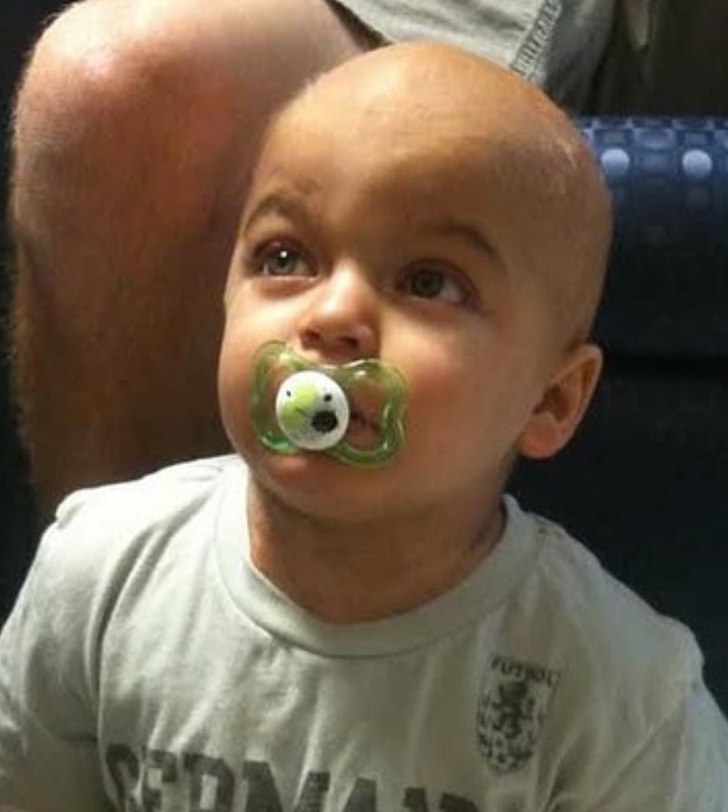Logan Pacl stands out among teenagers. At 17, he faces a rare illness known as Sanfilippo syndrome. Often called “childhood Alzheimer’s,” this cruel disorder gradually takes away a child’s cognitive skills, mirroring the effects of Alzheimer’s in older people. But he keeps fighting and uses social media to spread awareness about his condition.
At first, everything seemed normal.

Logan Pacl’s life is a battle against time. Diagnosed with Sanfilippo syndrome, often known as “childhood Alzheimer’s,” the 17-year-old from Silverdale faces a relentless genetic disorder that viciously strips away the very essence of childhood. Caused by a single defective gene, this neurodegenerative disease attacks the brain and spinal cord, leaving behind a cruel wake of lost abilities, seizures, and constant pain. It’s a ticking time bomb, as most children with this terminal illness don’t survive beyond their mid-teens.

For Logan’s family, the heartbreak began early. Born in 2007 with his twin brother Austin, Logan seemed like any other healthy baby. Both boys hit their developmental milestones—until Logan began to fall behind. A year in, the red flags emerged: while Austin was speaking, Logan remained silent. The difference between the brothers grew, signaling the start of a devastating journey.
Sanfilippo syndrome doesn’t just rob children of their future—it erases their past.
Then the news of the diagnosis hit the parents, something no one could have anticipated.

As Logan’s condition worsened, with chronic infections and a noticeably swollen belly, Noelle and William were left searching for answers. In January 2010, they learned that Logan had Sanfilippo syndrome, a terminal illness with no cure or treatment, and a life expectancy that typically extends only into the late teens. “I’ll never forget the day we got the phone call. The genetic counselor on the other end went on and on, and all I thought was, well get to the part on how we fix this. Then she said it, ’This disease is terminal, and there is no cure or treatment,’” his parents recall.
Noelle recalled her initial reaction, grappling with the news that the disease was terminal. The weight of the diagnosis was overwhelming, leaving her with a heart that felt as though it had dropped into her stomach. The severity of the situation rendered her unable to process much beyond the devastating reality.

Noelle described the experience of mourning not just the child she had but the life she had envisioned for him, a life that was abruptly stolen away. The medical advice they received was minimal and unhelpful, simply advising them to take Logan home and cherish their time with him. This lack of concrete guidance only deepened their sense of helplessness.
In their search for hope, Noelle and William discovered an experimental stem cell transplant through online research. Inspired by the success of another mother’s child, they decided to pursue the same treatment for Logan. So, Pacl went through a tough three-month treatment that was basically a bone marrow transplant. He had to endure chemotherapy to wipe out his immune system so it could accept the new stem cells. It was a risky procedure, but it seems to have helped with some of Logan’s physical symptoms.
His mother uses social media to spread awareness about his condition.

At 17, Logan’s life is very different from that of most teenagers. Losing his ability to speak at a young age was tough for him and his family, but over time, he’s become more easygoing. “Life with Logan is anything but typical. Each day is a battle to maintain the skills he still has,” his mother Noelle said.
Since 2020, Noelle has been a vocal advocate for Sanfilippo syndrome, using TikTok to share her family’s story. Her videos have reached a global audience, raising awareness about the disorder and encouraging other parents to seek early diagnosis for their children.

Although Logan’s future is uncertain, the Pacl family is committed to making the most of their time together. Noelle and William used to avoid thinking about what lies ahead, but now they focus on cherishing every moment with Logan and ensuring he enjoys his time to the fullest. Noelle notes that among Sanfilippo parents, there’s a bit of a joke that all their children seem like siblings, sharing similar features like bushy eyebrows, a low nasal bridge, and large, round stomachs.

Even with the demands of caring for Logan, Noelle keeps life as normal as possible for Logan’s siblings, Austin and Aidyn. She acknowledges that having a brother with special needs can bring its own set of benefits.
As for sharing Logan’s journey online, Noelle remains thoughtful about what she posts. While she plans to continue sharing, she’s careful to respect her family’s privacy. “We just live in the moment,” his mother said. “And if something comes up, and we’re like, we can make that, we’ll do it.”
People in comments react differently.

Mostly people express support and empathy.
- You take the most wonderful care of him. You are the greatest mom. © lauralang1108 / Instagram
But some show a bit of skepticism.
- Genuine question, what is your plan when you are gone? © devin_abq.505 / Instagram
- I just wanna know why it’s necessary. People have to publicize their children’s conditions. Why do people think that we all wanna know what’s wrong with your child? I feel sorry for the parents, but I don’t know why you want to put this all out there. I’m sure you have support group publicizing putting your child out there like this. © marlawomble / Instagram
Today, conversations about living with disabilities are becoming more open, especially on social media. Celebrities are sharing their experiences as parents of children with special needs, helping to normalize these discussions and inspire others. This shift fosters understanding and empathy, creating a more inclusive environment for everyone.
Este sou eu e meus pais minutos antes de eu expulsá-los do meu casamento quando descobri a verdade

De pé no meu próprio casamento, eu estava felizmente inconsciente de que meu mundo estava prestes a se despedaçar. Uma única explosão da minha madrinha mudou tudo, revelando uma traição oculta que me forçou a confrontar a dolorosa verdade e embarcar em um caminho de autodescoberta e renovação.
Conheci Derek há cinco anos, durante nosso segundo ano de faculdade. Foi um daqueles momentos clichês em que você esbarra em alguém e papéis voam para todo lado. Exceto que, no nosso caso, era uma pilha de livros, e um deles me atingiu em cheio no rosto.

Uma mulher esbarra em um homem no campus de uma faculdade e livros são espalhados ao redor deles | Fonte: Midjourney
“Sinto muito!”, ele disse, lutando para juntar os livros. Eu ri, cuidando de um leve hematoma na testa. Daquele momento em diante, Derek e eu éramos inseparáveis.
Nosso relacionamento não era perfeito, longe disso. Derek era o clássico com fobia de compromisso. Toda vez que nosso relacionamento parecia atingir um novo marco, ele encontrava uma maneira de evitá-lo. Morar juntos? Ele alegava que seu apartamento era muito pequeno.
Conhecer meus pais? De repente, ele teve uma “emergência de trabalho”. Apesar de tudo isso, eu o amava. Ele era gentil, engraçado e incrivelmente solidário quando mais importava.

Um casal rindo | Fonte: Midjourney
Nunca vou esquecer o dia em que ele me pediu em casamento. Era tão fora do personagem dele. Estávamos no nosso parque favorito, aquele com o velho carvalho onde havíamos esculpido nossas iniciais. Ele se ajoelhou, e eu não conseguia acreditar. “Abigail, você quer se casar comigo?”, ele perguntou, seus olhos sinceros.
Fiquei tão chocada que quase esqueci de dizer sim. Meus pais ficaram emocionados. Eles sempre gostaram de Derek, apesar de sua relutância em se estabelecer. Eles nos deram uma festa de noivado e até se ofereceram para pagar o casamento. Era a maneira deles de mostrar apoio, ou assim eu pensava.

Uma mulher abraçando o namorado após um pedido romântico em um parque | Fonte: Midjourney
Avançando para o dia do casamento. O cenário da praia era perfeito, o céu de um azul brilhante e o som das ondas adicionavam um pano de fundo sereno. Minha madrinha e melhor amiga, Julia, estava me ajudando com os toques finais na suíte nupcial.
Julia foi minha rocha em todos os altos e baixos, sempre pronta com uma taça de vinho e um ouvido atento.
“Pronta para me tornar a Sra. Derek Hoffman?” ela provocou, ajustando meu véu.
“Não acredito que isso está realmente acontecendo”, respondi, com o coração batendo forte de excitação e nervosismo.

Uma linda configuração de casamento na praia | Fonte: Midjourney
Enquanto caminhávamos até onde o fotógrafo tinha se instalado, senti uma alegria avassaladora. Meus pais estavam ao meu lado, radiantes de orgulho. Posamos para uma foto, nós três sorrindo amplamente.
Mas assim que o fotógrafo clicou o obturador, ouvi um estrondo alto. Julia tinha derrubado seu copo intencionalmente, e seu rosto estava bravo.
“Ah, vamos lá!” ela gritou, sua voz cortando a atmosfera festiva. “Vamos ficar aqui e fingir que nada aconteceu?”

Uma noiva posando para uma foto com seus pais | Fonte: Midjourney
Meus pais ficaram tão pálidos quanto a areia sob nossos pés. Senti um arrepio percorrer minha espinha. Algo estava terrivelmente errado.
“Julia, o que está acontecendo?”, perguntei, minha voz tremendo. “Do que você está falando?”
Os olhos de Julia estavam fixos em meus pais. “Você precisa contar a verdade a ela”, ela disse firmemente. “Ela merece saber.” As mãos da minha mãe começaram a tremer. “Este não é o momento nem o lugar…” ela começou, sua voz vacilante.
“Por favor, não vamos fazer uma cena”, meu pai acrescentou, olhando nervosamente para os convidados reunidos.

Uma dama de honra parecendo preocupada e chocada em um casamento na praia | Fonte: Midjourney
“Que verdade?”, exigi, minha confusão se transformando em raiva. “O que você está escondendo de mim?”
Julia deu um passo mais perto, seu olhar inabalável. “Eu ouvi seus pais conversando alguns minutos atrás. Eles pagaram Derek para te pedir em casamento. Eles estavam mexendo os pauzinhos esse tempo todo, e nós não tínhamos ideia. Sinto muito, Abi, mas eu não consegui esconder isso de você.”
O tempo pareceu parar. “O quê?”, sussurrei, minha mente girando. “Isso não pode ser verdade. Isso é algum tipo de piada doentia?”

A mãe de uma noiva chorando | Fonte: Midjourney
Os olhos da minha mãe se encheram de lágrimas. “Fizemos isso porque amamos você”, ela soluçou. “Vimos o quanto você o amava e o quão devastada você ficava sempre que brigavam. Achamos que se ele a pedisse em casamento, tudo ficaria bem e você seria feliz de novo.”
Meu pai assentiu, seu rosto marcado pela culpa. “Nós só queríamos garantir sua felicidade. Nunca quisemos que isso acontecesse assim.”
Virei-me para Derek, que estava ali, parecendo envergonhado. “Eu deveria ter te contado”, ele disse calmamente. “Eu queria, mas estava com medo de te perder.”

Um homem de meia idade muito triste e emocionado no casamento de sua filha | Fonte: Midjourney
Lágrimas brotaram em meus olhos. “Você não tinha o direito de interferir na minha vida desse jeito”, eu disse, minha voz embargada. “Essa deveria ser minha decisão, minha felicidade. Você traiu minha confiança.”
“Por favor, não faça isso”, minha mãe implorou. “Fizemos isso por amor.”
“Por amor?”, cuspi, minha raiva aumentando. “Isso não é amor. Isso é manipulação. Quero que você saia do casamento agora.”
“Por favor, pense sobre isso…” meu pai começou a dizer, mas eu o interrompi.
“Não há nada para pensar. Você precisa ir embora. Agora.”

Uma noiva chorando em seu casamento | Fonte: Midjourney
Enquanto eles se afastavam, o peso da traição deles me esmagou. O casamento parou, e sussurros se espalharam entre os convidados como fogo. Fiquei ali, uma tempestade de emoções rugindo dentro de mim: raiva, tristeza, traição.
O dia que deveria ser o mais feliz da minha vida se transformou em um pesadelo, e eu tive que juntar os cacos.
Virando-me para Derek com um olhar severo, senti meu coração se despedaçar em um milhão de pedaços. “Não acredito que você fez isso”, sussurrei, minha voz tremendo com a traição.

Uma noiva discutindo com seu noivo em seu casamento | Fonte: Midjourney
Ele olhou para baixo, incapaz de encontrar meus olhos. “Eu ia usar esse dinheiro para nossa família. Seus pais fizeram parecer que era a única maneira de garantir nosso futuro juntos.”
Lágrimas brotaram em meus olhos enquanto eu balançava a cabeça. “Este não é um futuro construído em amor e confiança. É construído em mentiras e manipulação. Não posso me casar com alguém que me trairia assim.”
“Por favor, podemos resolver isso”, ele disse desesperadamente, se aproximando. “Eu te amo.”
“O amor não deveria ser assim,” eu disse firmemente, as lágrimas agora escorrendo pelo meu rosto. “Eu preciso que você vá embora. Agora.”

Um noivo triste deixando o local do casamento em lágrimas | Fonte: Midjouney
“Não faça isso. Nós podemos consertar”, ele implorou, com a voz embargada.
“Não. Acabou. Vá embora,” eu disse com firmeza, meu coração doendo.
Ele saiu, seu rosto cheio de tristeza e arrependimento. Senti uma estranha sensação de alívio, mesmo em meio à dor. Eu sabia o que precisava fazer em seguida.
No dia seguinte, arrumei minhas coisas. Ficar no mesmo estado, cercado por memórias de engano e traição, era impossível. Eu precisava de um novo começo, em algum lugar distante, onde eu pudesse reconstruir minha vida nos meus termos.

Uma mulher triste e solitária sentada em seu quarto | Fonte: Midjourney
Escolhi um estado em que sempre sonhei em viver, cheio de oportunidades e a promessa de novos começos. A transição não foi fácil. Os dias foram difíceis no começo, cheios de solidão e dúvida, mas eu continuei.
Julia me ajudou com a mudança. “Você está fazendo a coisa certa”, ela me abraçou com força. “Você merece um novo começo.”
“Espero que sim”, respondi, sentindo o peso da minha decisão. “É assustador, mas preciso fazer isso.”
O novo estado era tudo o que eu esperava ser: vibrante, cheio de energia e potencial.

Uma mulher sentada sozinha em seu apartamento | Fonte: Midjourney
Encontrei um pequeno apartamento com um charme aconchegante e consegui um emprego que se alinhava com minhas paixões. Trabalhar como designer gráfico sempre foi um sonho, e agora eu finalmente estava tornando isso realidade.
As primeiras semanas foram difíceis. Eu acordava no meio da noite, assombrada pelas memórias do meu casamento arruinado. Eu sentia falta dos meus pais, apesar da traição deles, e a solidão era quase insuportável.
Ao desempacotar a última das minhas caixas uma noite, encontrei um velho álbum de fotos. Folheando as páginas, me deparei com uma foto minha e de Derek, rindo em um piquenique.

Uma mulher se sentindo triste enquanto olha para um álbum de fotos antigo | Fonte: Midjourney
A alegria em nossos rostos parecia uma memória distante. Fechei o álbum, determinado a focar no futuro.
Eu me joguei no trabalho, muitas vezes ficando até tarde no escritório. Meus colegas eram amigáveis, e eu lentamente comecei a me abrir. Uma delas, Sarah, me convidou para participar de um grupo de caminhadas local.
“Você deveria vir”, ela disse uma tarde. “É uma ótima maneira de conhecer novas pessoas e clarear sua mente.”
“Por que não?”, respondi, me surpreendendo. “Eu poderia usar uma boa caminhada.”

Uma mulher trabalhando em um laptop em seu escritório | Fonte: Midjourney
A primeira caminhada foi desafiadora, mas foi incrível forçar meus limites. O grupo foi acolhedor, e eu rapidamente fiz amigos. Nós compartilhávamos histórias e ríamos ao redor de fogueiras, o ar fresco da montanha fazendo maravilhas para meu espírito.
Conforme as semanas se transformavam em meses, eu me vi aproveitando as pequenas coisas: café da manhã em um café local, mercados de produtores de fim de semana e viagens de carro espontâneas com novos amigos. A cada dia, eu me tornava mais independente e confiante na minha capacidade de criar uma vida que fosse verdadeiramente minha.

Uma mulher feliz em uma caminhada com seus amigos | Fonte: Midjourney
Numa tarde ensolarada, enquanto subia uma trilha particularmente íngreme, parei para recuperar o fôlego. Olhando para o vale abaixo, percebi o quão longe eu tinha chegado. A dor e a traição do meu passado ainda persistiam, mas não me definiam mais.
Sarah veio até mim, me entregando uma garrafa de água. “Você tem aquele olhar,” ela disse com um sorriso.
“Que olhar?”, perguntei, tomando um gole.
“O olhar de alguém que finalmente encontrou seu lugar.”
Eu sorri, sentindo um calor se espalhar por mim. “É, acho que sim.”

Uma mulher se sentindo feliz na natureza | Fonte: Midjourney
A vida não era perfeita, mas era minha. Eu a estava construindo pedaço por pedaço, nos meus termos. E pela primeira vez em muito tempo, me senti genuinamente feliz. Enquanto eu estava ali, com o sol se pondo à distância, eu sabia que tinha feito a escolha certa. Este era meu novo começo, e eu estava pronto para abraçar cada momento dele.
Acha que essa história foi adorável? Aqui vai outra: Paige acha que encontrou o amor de sua vida em Aaron até que uma espionagem acidental expõe uma trama enganosa envolvendo seu casamento que se aproxima. Com a traição em primeiro plano, Paige deve decidir se confronta a verdade de frente ou se afasta do que poderia ter sido o maior erro de sua vida.

Uma jovem mulher vestindo um top branco floral | Fonte: Pexels
Este trabalho é inspirado em eventos e pessoas reais, mas foi ficcionalizado para fins criativos. Nomes, personagens e detalhes foram alterados para proteger a privacidade e melhorar a narrativa. Qualquer semelhança com pessoas reais, vivas ou mortas, ou eventos reais é mera coincidência e não intencional do autor.
O autor e a editora não fazem nenhuma reivindicação quanto à precisão dos eventos ou à representação dos personagens e não são responsáveis por nenhuma interpretação errônea. Esta história é fornecida “como está”, e quaisquer opiniões expressas são as dos personagens e não refletem as opiniões do autor ou da editora.



Leave a Reply